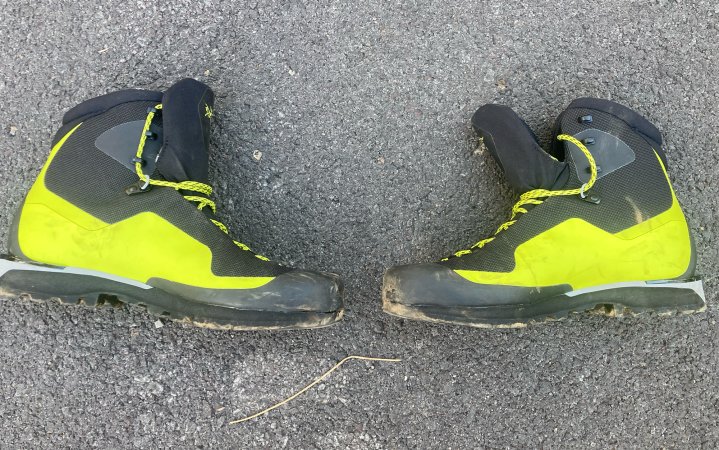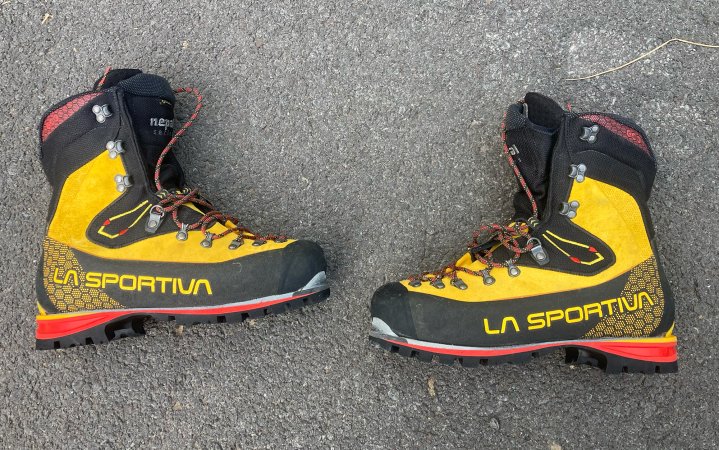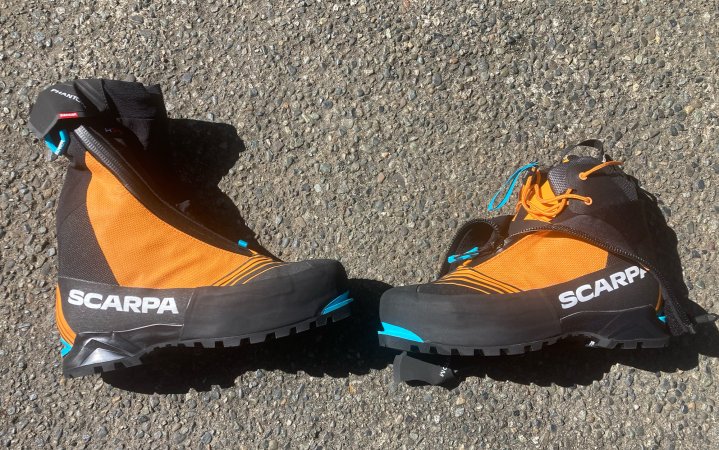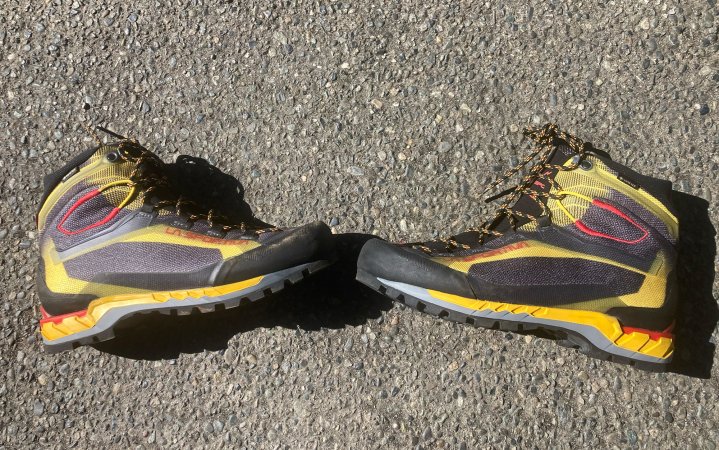We may earn revenue from the products available on this page and participate in affiliate programs. Learn More ›
If you think about the single action or movement that an alpine climber does the most, it has to be taking a step. It may not be the most glamorous aspect of mountain climbing, but the truth is that the sport mostly boils down to practicing the simple art of putting one foot in front of the other. If you can keep doing this for long enough, in whatever kind of terrain or conditions the mountain throws at you, you’ll reach the summit. Of course, then you’ll have to turn around and keep doing it to get down safely too.
With so much time spent on your feet, selecting the right mountaineering boots is crucial to success when venturing out in the hills. Do you want to avoid being in pain all day? Your boots better fit right. Do you want to feel all your toes and keep them? Your boots better be warm enough. Do you want to move efficiently on snow, ice, rock, dirt, or some mix of all of them? Your boots better be designed to perform. With this in mind, I set out to try the best mountaineering boots and sort out which ones rise above the field to keep you climbing higher.
How I Tested the Best Mountaineering Boots
Sean McNally
I tested the best mountaineering boots by using them to summit technical peaks, covering glaciers, snowfields, vertical ice pillars, talus fields, rock ridges, and long slog approaches on dirt trails. I work as a guide primarily in the Pacific Northwest so most of the miles took place in the vast and rugged Cascade Mountain Range, but I’ve used these boots in other ranges across the U.S. as well.
While testing these boots, I focused primarily on comfort, fit, warmth, and performance across a variety of alpine climes. When judging these boots, I put extra emphasis on how they handled snowy and icy conditions. I especially focused on their ability to arrest a fall and perform a crevasse rescue. I weighed these functions a bit more heavily because if you’re reaching for a mountain boot, you’re likely planning to move through snow or ice on your route, otherwise you might consider less-beefy footwear.
Conditions while testing ranged anywhere from sweltering summer temps in the PNW to frigid winter days where the thermometer couldn’t even sniff 0 degrees Fahrenheit. After putting these boots through some mountain abuse and more steps than I can count. I’ve sorted the best mountaineering boots by the terrain where they shine.
Best Mountaineering Boots: Reviews & Recommendations
Best Overall: Arc’teryx Acrux LT GTX Boot
Key Features
- Weight: 650 g (per boot)
- Heel welt
- Full length carbon plate
Pros
- Climbs rock well for how stiff the boot is
- Stiff enough to kick steps in snow and ice
Cons
- Fit is narrow and long
- Toes get cold in low temps
- No toe welt means it’s only compatible with semi-automatic crampons
Trying to find a mountaineering boot that does it all can be a bit of a fool’s errand. Boots that are great for hiking and scrambling tend to be too soft for efficient glacier travel and boots that are stiff enough to kick around on glaciers are often too clunky for precise foot placement on rock. But, the Arc’teryx Acrux LT GTX boot does a fantastic job of executing on both tasks. I was very impressed by the stiffness of this boot for gaining purchase on glaciers, climbing low angle ice, and executing a crevasse rescue.

Sean McNally
The Acrux LT is also low profile and light so it doesn’t feel clunky or burdensome when scrambling or climbing. It’s perfect for those routes that require transitions between glacier and rock without making a footwear change. I was able to wear this boot all day on a route in the Cascades that requires a long approach as well as snow, ice, and rock climbing.

Sean McNally
I will say that your toes might get cold in this boot when climbing in wintery conditions. It seems that the Acrux was designed with summer alpine weather and conditions in mind. The fit is also a little narrow, which meant my toes had some room at the end due to my high-volume foot. Try it on before committing to dropping the cash on a pair of these. But if you do decide to invest in the Acrux, you’re going to have yourself a high performing, do it all, alpine climbing boot that isn’t going to slow you down at terrain transitions.
Read Next: Best Crampons
Best for Glaciers: La Sportiva Nepal Cube GTX
Key Features
- Weight: 894 g (per boot
- Heel and toe welts
Pros
- All day comfort on long glacier slogs
- Stiff, beefy sole for all day kicking
- Keeps toes warm in cold temps
- Works well with different crampon styles
Cons
- Not precise for climbing rock
- Not comfortable for long hikes
The La Sportiva Nepal has got to be the most popular mountaineering boot around — and for good reason. It’s the perfect workhorse for mountaineers grinding their way up long snaking glaciers. I chose the Nepal Cube GTX in this round up review because it’s slightly lighter than the original Nepal, but includes everything I love about the classic. With a stiff sole, warm insulation, and roomy fit, this boot will keep you kicking steps all day in even sub optimal mountain conditions. The heel and toe welts allow you to pair it with almost any style of crampon with either automatic or semi-automatic configuration. This boot is recommended on all of the intro to mountaineering and crevasse rescue courses that I teach for budding mountain enthusiasts.

Sean McNally
The Nepal Cube can do a lot more than low angle snow and ice, too. I’ve used this boot climbing vertical water ice in the winter and the stiff sole provides a nice solid platform when your front points are punched into the ice.

Sean McNally
The main weak spot for this boot is climbing or scrambling on rock. The thick sole doesn’t allow for very precise foot placement but does well if you can land it on a pronounced rock edge. While many people do use this boot to approach their climb, I often opt to strap it to my pack for the hike in because the stiff sole can put some extra stress on your joints if it’s hard packed dirt. Still, the La Sportiva Nepal Cube GTX is a classic of the genre and has accompanied mountaineers to the top of snowy summits probably more than any other mountain boot out there.
Best for Ice Climbing: Scarpa Phantom Tech
Key Features
- Weight: 800 g (per boot)
- Heel and toe welts
- Integrated gaiter
Pros
- Stiff sole for solid climbing platform
- Compatible with automatic and semi-automatic crampons
- Ankle flexes for precise foot placements
- They look really cool
Cons
- Difficult to climb rock in
- Can get cold
Kick, kick, swing. That’s the beat to ice climbing and nothing feels better than when you’re climbing in rhythm. So if the ice is fat and you want to hit the dance floor, look no further than the Scarpa Phantom Techs. These boots sport a stiff sole so you can confidently stand up on a solid platform after plunging your front points into the ice. Both a heel and toe welt means you can enjoy the security of an automatic binding system on your crampons.

Sean McNally
The boot is also low profile with some ankle flexion, which allows you to get precise and techy with your footwork if it’s required. Some boots are so bulky that vertical climbing can feel like trying to hit a nail with a sledgehammer, but the Phantom Techs provide a sturdiness that doesn’t feel unwieldy.
The stiffness of the sole also makes them appropriate for glacier travel where arresting a fall and performing a crevasse rescue might be required. This paired with all day comfort makes them a great boot if you plan to ice climb all winter and also do some summer mountaineering. The integrated gaiter keeps the laces tucked away nicely, eliminating the possibility of a crampon or anything else snagging them while climbing.

Sean McNally
I did find that my toes got cold sometimes with the Phantom Techs, a trade off of their low-profile design. And just like any boot with a rigid sole, these are challenging to rock climb in, however, the play in the ankle makes up for some of the difficulty by allowing more range in foot position. But these are small draw backs if you’re primarily an ice climber, because when it comes to scaling frozen waterfalls with picks and points, these are the dancing shoes you want to lace up.
Best for Alpine Rock: La Sportiva Trango Tech GTX
Key Features
- Weight: 620 g (per boot)
- Heel welt
- Vibram rubber sole with climbing zone
Pros
- Rock climbs and hikes like an approach shoe
- Compatible with semi-automatic crampons
Cons
- Not ideal for kicking lots of steps in ice or firm snow
- Not very warm
- Have to replace them every one to two years
At some point, most climbers have tried strapping a crampon to their approach shoes. Although not an advisable strategy, sometimes a climber sacrifices security and safety on the snow in order to gain performance on the rock. If this sounds like you, the La Sportiva Trango Tech was designed with you in mind.

Sean McNally
The Trango Tech is a mountain boot that performs unusually well on rock due to the soft sole that allows the toe to bend. This means it climbs more like an approach shoe rather than a mountain boot because it is far more comfortable and you can smear with it on a smooth wall instead of just hunting for edges to stand on.
It also comes equipped with a heel welt so it’s compatible with semi-automatic crampons, adding some security between the boot and crampon interface. With good technique, arresting a fall on snow in this boot is a much better prospect than with a crampon strapped to an approach shoe.

Sean McNally
The soft sole on the Trango Tech makes it an undesirable boot for kicking lots of steps into hard or icy snow. Any efficiency you gain in weight savings or climbing ability, you might lose just hacking away to get to your route. This boot was designed for the summertime. Any prolonged time in really deep snow or wintery temps will result in cold toes and snow packing in over the top of the boot.
Read Next: Best Approach Shoes, Trail and Crag Tested
How to Choose the Best Mountaineering Boots

Sean McNally
Mountaineering boots are not a purchase to take lightly. They cost a pretty penny and you’re trusting them to keep you from getting frostbite or slipping off a mountain, so it’s worthwhile making sure you’re investing in the right pair. Here are some things to consider when setting out to find the right mountain boots for you.
Try Them On
Go into a store and try the boots on. Or order multiple pairs and plan to utilize an online retailer’s return policy. It is worth the time and effort to actually walk around in a pair of mountaineering boots before trying to summit a peak in them. Everyone has different feet and brands have different sizing, so it’s really the only way to ensure you’re not going to be in a ton of pain when you should be focused on your climb.
If you can’t find the pair of boots you want in a store to try on, one trick is to try on a bunch of different styles from the same company. It’s not an exact science but it will at least help you get close to dialing in the right size for that brand.
Start General, Get Specific
If you’re buying your first set of mountaineering boots, go ahead and start with a pair designed for general mountaineering. These boots usually work well enough across a variety of mountain climbing terrain that you can get a lot of use out of them before you start figuring out what designs and styles you really need.
If you find yourself drawn to scaling frozen columns of water in the dead of winter, you may opt for a boot tailored for ice climbing next. If you start to feel that crossing snow is just a necessary evil to get to the sweet exposure you crave on a long summit ridge, a pair that rock climbs well is your next move. Most climbers end up with a quiver of boots in their gear closet anyway, so you’ve got plenty of time to amass a collection of specialized mountain footwear as you gain experience.
Don’t Wait to Replace Them
Mountaineering boots take abuse, which they are meant to do. The more you venture into the hills, the more pairs of boots you’re going to burn through. If the boots start taking on water or the soles are getting worn and floppy, it’s time to replace them. Your feet are going to thank you for it.
With mountaineering boots being so expensive, people often wait way too long to replace them and then miss out on the performance, warmth, and moisture protection that a fresh pair of boots provide. Remember that climbing mountains is hard enough as it is. You don’t need to add unnecessary misery to the experience by wearing cold, wet, sloppy boots.
Final Thoughts on the Best Mountaineering Boots
Alpine climbing requires efficient travel on any mix of terrain including dirt, rock, snow, and ice. A quality pair of mountain boots goes a long way toward making sure you can climb safely and comfortably on any and all of this terrain. With a clear understanding of the different features available and an ability to match that to the type of alpine climbing you plan to do, you should have no problem finding a high quality, hardworking boot on this list that is going to accompany you on some of your best days outside.




